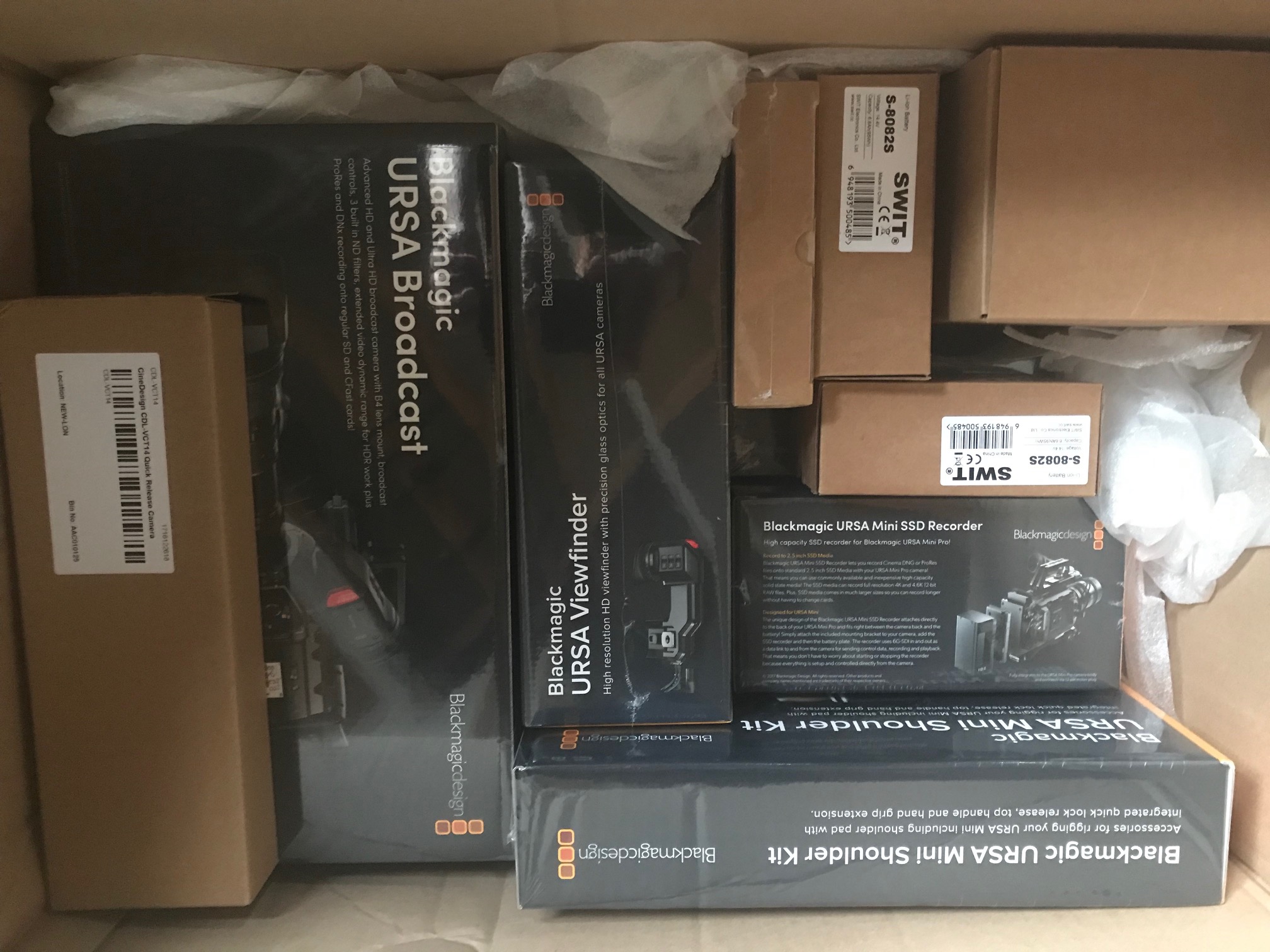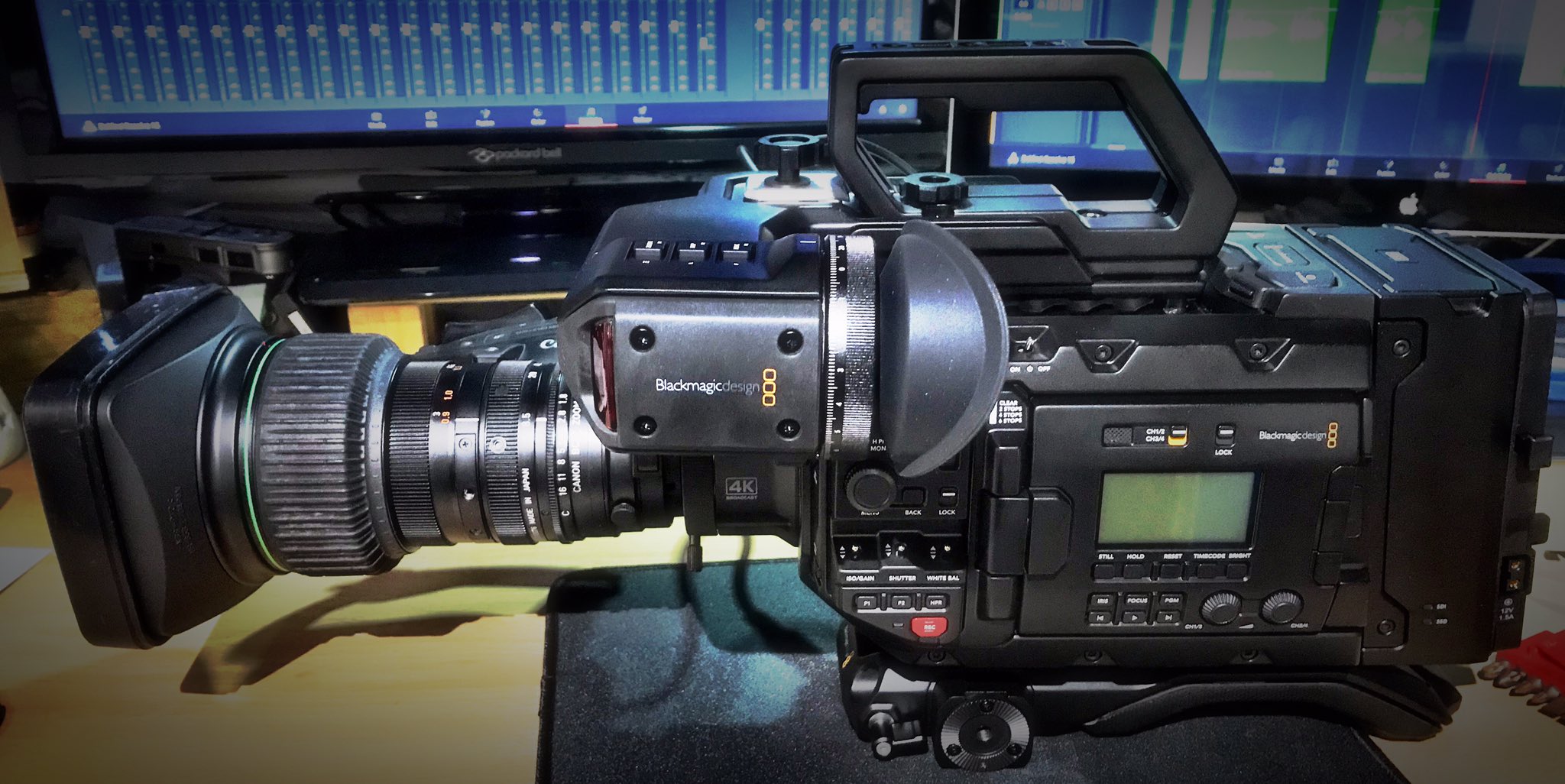Blackmagic XMAS
27/12/18 16:48 Filed in: Production | Cameras
Well, Santa has been! On XMAS eve, thanks to VisualImpact, my Blackmagic URSA Broadcast package arrived. Of course, I needed to check it over Xmas to make sure everything was in order ;)


You may be wandering why, out of all the cameras, did I choose the URSA Broadcast? Some history ….
For 14 years I have mainly been a Canon camera owner. I started with the SD Canon XM2, then moved quickly to the Canon XL2, also SD DV. Although what was called a "Prosumer" camera, it was not a full ENG camera, being a DV Camera, but it had some features that were a real pull, such as interchangeable lenses (for Canon XL lenses made specifically for this range), an EF lens adapter, changeable viewfinder, buttons instead of deep menu system, and a really good audio system. The lens that came with the camera was a 20x lens with electronic aperture and zoom controls. The focus ring however, had no end stops, but the beauty of this range was the fact that you could change things. I got the black and white viewfinder, which was so much nicer than the colour LCD, and a 16x Manual focus lens with switchable zoom control, i.e. you could control the zoom manually and do whip zooms if you really wanted to or get to the framing you want really quickly. When you attached and EF lens, via the XL=>EF adapter, you got an instant 7x magnification factor, so good for getting wildlife, but for dramas / corporate work, not so practical. All in all, I really liked the whole practical design of this camera but the picture quality was fast becoming obsolete because of the arrival of HD at that time, but the new model, the XLH1 (HD version) was out of my price range. The XL2 also had a small sensor which in combination with the stock lens, had a deep depth of field.
The era of screw in 35 mm lens adaptors arrived which you put in front of your stock lens. You then put an EF lens on the adaptor which focussed the image onto a ground glass plane, then focussed your stock lens onto the ground glass plane. All of a sudden you get all the properties of 35mm film on a SD DV camera!! (Well clearly not the resolution, but certainly the aesthetics and shallow depth of field, albeit at the cost of a stop of light!). This did improve things, but made the camera and accessories quite something to carry as it added lots of weight because you were using two lenses as well as a heavy adapter. Oh, and one real disadvantage, the image was inverted, so not the easiest setup to use!
In 2009, I needed to really upgrade to HD and I also get a new stills camera. This was at the time where DSLR's were just evolving into being able to take HD video, so it made sense to feed two birds with one worm, and get the Canon 7D. For video this was transformative. Shallow depth of field in a handheld camera, high quality output onto a CF card, way better light performance and a whole range of lens choices. Now I like many, found the DSLR to be a revolution, BUT, the drawbacks were many. A smaller camera means less stability, less stability on a camera without a global shutter meant wobbly video, a maximum record time of 12 minutes per clip (no good for event work), etc etc. Perhaps the thing I missed the most through all the shallow depth of field, was the ergonomics of the ENG camera and especially the par focal zoom lens.
A few years later, the successor to the XL2 was becoming cheaper on eBay, and this was the Canon XLH1. This also came at the same time that companies like Atomos where making external hard disk / SSD recorders that took SDI signals and recorded edit ready footage in ProRes 422. The XLH1 came with a new HD lens but all the accessories, from the viewfinder, batteries, EF adaptor and even the manual 16x zoom from the XL2, all worked with it. Again, this camera is tape based but upgraded to "hdv" which is still a horribly compressed format, BUT the camera was also designed for studio use, so came with additional SDI out, Timecode IN/OUT etc. The SDI out is an uncompressed 10-bit signal which can feed straight into an Atomos Samurai. So for a few hundred UK pounds, it was a no brainer. I still use this camera today for some things, but again, technology moves on, and HD has been superseded by 4K, but it's not just about the resolution of the image, camera technology has massively advanced in terms of colour science and also the amount of stops of light that can be captured.
So back to the original question, out of all the cameras, why the URSA Broadcast? Out of the URSA range, I believe that this model provides the best compromise for a general use camera that can be used for corporate work, wildlife, and drama / artistic projects. It accepts via an ingenious B4 lens adapter, standard broadcast B4 lenses which of course are designed with the versatile requirements needed, and is also par focal. For me, this camera is the next logical progression. It does everything that the old Canon XL?? range did, and more. It is 4K which, as I am delivering most of my content in HD, gives additional re-framing options in post production for some projects, and captures exception resolution for others. It has the well respect Blackmagic colour science and obviously, is designed in the same vein as the companion Davinci Resolve product in that it is well engineered.
For now, I have purchased a cheap second hand SD Canon B4 lens. I will be getting familiar with the camera of the next few weeks / months and will go through many options like timecode etc. As I have been used to using SSDs with the Canon XLH1s, I opted for the Blackmagic SSD recorder which bolts onto the back before the V-Mount batteries. I am confident that this camera was the right purchase and if Blackmagic release updates in the same way as they do with their software, I hope they put the Blackmagic RAW codec onto this model at some point, but for now, there is plenty for me to get to grips with! Which reminds me, the only downside is that the URSA Broadcast doesn't come with the handgrip that the URSA mini does, probably because it's designed mostly for use with B4 lenses, but as it's so versatile, I will be using it with EF lenses too which means I will need to get the handgrip separately. Anyway, that's for the future, for now, looking forward to getting up to speed with this camera for the new year.

For 14 years I have mainly been a Canon camera owner. I started with the SD Canon XM2, then moved quickly to the Canon XL2, also SD DV. Although what was called a "Prosumer" camera, it was not a full ENG camera, being a DV Camera, but it had some features that were a real pull, such as interchangeable lenses (for Canon XL lenses made specifically for this range), an EF lens adapter, changeable viewfinder, buttons instead of deep menu system, and a really good audio system. The lens that came with the camera was a 20x lens with electronic aperture and zoom controls. The focus ring however, had no end stops, but the beauty of this range was the fact that you could change things. I got the black and white viewfinder, which was so much nicer than the colour LCD, and a 16x Manual focus lens with switchable zoom control, i.e. you could control the zoom manually and do whip zooms if you really wanted to or get to the framing you want really quickly. When you attached and EF lens, via the XL=>EF adapter, you got an instant 7x magnification factor, so good for getting wildlife, but for dramas / corporate work, not so practical. All in all, I really liked the whole practical design of this camera but the picture quality was fast becoming obsolete because of the arrival of HD at that time, but the new model, the XLH1 (HD version) was out of my price range. The XL2 also had a small sensor which in combination with the stock lens, had a deep depth of field.
The era of screw in 35 mm lens adaptors arrived which you put in front of your stock lens. You then put an EF lens on the adaptor which focussed the image onto a ground glass plane, then focussed your stock lens onto the ground glass plane. All of a sudden you get all the properties of 35mm film on a SD DV camera!! (Well clearly not the resolution, but certainly the aesthetics and shallow depth of field, albeit at the cost of a stop of light!). This did improve things, but made the camera and accessories quite something to carry as it added lots of weight because you were using two lenses as well as a heavy adapter. Oh, and one real disadvantage, the image was inverted, so not the easiest setup to use!
In 2009, I needed to really upgrade to HD and I also get a new stills camera. This was at the time where DSLR's were just evolving into being able to take HD video, so it made sense to feed two birds with one worm, and get the Canon 7D. For video this was transformative. Shallow depth of field in a handheld camera, high quality output onto a CF card, way better light performance and a whole range of lens choices. Now I like many, found the DSLR to be a revolution, BUT, the drawbacks were many. A smaller camera means less stability, less stability on a camera without a global shutter meant wobbly video, a maximum record time of 12 minutes per clip (no good for event work), etc etc. Perhaps the thing I missed the most through all the shallow depth of field, was the ergonomics of the ENG camera and especially the par focal zoom lens.
A few years later, the successor to the XL2 was becoming cheaper on eBay, and this was the Canon XLH1. This also came at the same time that companies like Atomos where making external hard disk / SSD recorders that took SDI signals and recorded edit ready footage in ProRes 422. The XLH1 came with a new HD lens but all the accessories, from the viewfinder, batteries, EF adaptor and even the manual 16x zoom from the XL2, all worked with it. Again, this camera is tape based but upgraded to "hdv" which is still a horribly compressed format, BUT the camera was also designed for studio use, so came with additional SDI out, Timecode IN/OUT etc. The SDI out is an uncompressed 10-bit signal which can feed straight into an Atomos Samurai. So for a few hundred UK pounds, it was a no brainer. I still use this camera today for some things, but again, technology moves on, and HD has been superseded by 4K, but it's not just about the resolution of the image, camera technology has massively advanced in terms of colour science and also the amount of stops of light that can be captured.
So back to the original question, out of all the cameras, why the URSA Broadcast? Out of the URSA range, I believe that this model provides the best compromise for a general use camera that can be used for corporate work, wildlife, and drama / artistic projects. It accepts via an ingenious B4 lens adapter, standard broadcast B4 lenses which of course are designed with the versatile requirements needed, and is also par focal. For me, this camera is the next logical progression. It does everything that the old Canon XL?? range did, and more. It is 4K which, as I am delivering most of my content in HD, gives additional re-framing options in post production for some projects, and captures exception resolution for others. It has the well respect Blackmagic colour science and obviously, is designed in the same vein as the companion Davinci Resolve product in that it is well engineered.
For now, I have purchased a cheap second hand SD Canon B4 lens. I will be getting familiar with the camera of the next few weeks / months and will go through many options like timecode etc. As I have been used to using SSDs with the Canon XLH1s, I opted for the Blackmagic SSD recorder which bolts onto the back before the V-Mount batteries. I am confident that this camera was the right purchase and if Blackmagic release updates in the same way as they do with their software, I hope they put the Blackmagic RAW codec onto this model at some point, but for now, there is plenty for me to get to grips with! Which reminds me, the only downside is that the URSA Broadcast doesn't come with the handgrip that the URSA mini does, probably because it's designed mostly for use with B4 lenses, but as it's so versatile, I will be using it with EF lenses too which means I will need to get the handgrip separately. Anyway, that's for the future, for now, looking forward to getting up to speed with this camera for the new year.

blog comments powered by Disqus
